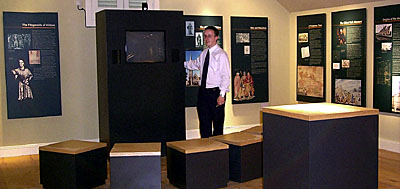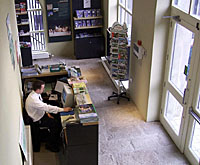
KILDARE, 9 July 2001: by Grace Halford. The recently refurbished Market House in Kildare Town as a new local heritage centre has already attracted visitors from all over the world, including America, Europe and Asia. Its early success is a classic example of various community organisations coming together with one goal.
 "The Market House in the square of Kildare is a focal point for tourism in the area and plays a significant part in the history of the town," says Eamonn Mulvihill Chairman of the Kildare Town Heritage Company. "Dating back to as early as the 19th century, it replaced an earlier structure which can be seen on Rocque’s Map of 1757. The upper story of the building was added in1886 in order to accommodate a cast iron water trough for the town; this now houses the audiovisual centre in the Market House."
"The Market House in the square of Kildare is a focal point for tourism in the area and plays a significant part in the history of the town," says Eamonn Mulvihill Chairman of the Kildare Town Heritage Company. "Dating back to as early as the 19th century, it replaced an earlier structure which can be seen on Rocque’s Map of 1757. The upper story of the building was added in1886 in order to accommodate a cast iron water trough for the town; this now houses the audiovisual centre in the Market House."
Kildare has always been regarded as a market town and this was recognised by King Henry VIII who in 1515 AD granted the town a Charter recognising Thursday as a market day and this continues to present day with the weekly market still attracting large crowds.
In 1992 the Kildare Town Heritage Company was formed in an effort to gain heritage status for the town of Kildare. The company, which incorporates several organisations within the town, includes representatives from the Kildare Historical Society, the Chamber of Commerce, the Friends of St Brigid’s Cathedral, Cairde Bride and the Tidy Towns Committee.
Heritage status was achieved by the town in 1994 and in 1999 European Regional Development Funding to the amount of £228,688 along with £50,000 from Kildare County Council was made available to the KTHC in order to develop the Market House into a Heritage Centre and Tourist Office. However the company must raise another £20,000 and fundraising is still on going.
The centre is now in place and an important addition to the town. It comprises an audiovisual presentation and wall plaques, which illustrate the history of the town dating back to the time of St Brigid. As Padraig Maher, manager of the centre says, ‘it will in the future, house models of the area and other items of local interest’.
There was some initial criticism over the finish which was applied to the outside of the building. It was felt by some, that it did not look as authentic as they would have imagined. But as Eamonn Mulvihill explained, the finish was in fact ‘lime rendered plaster’, which was recommended by the Historical Society as an appropriate finish in keeping in line with the period. He also said that the building was constructed originally using random or rubble stone and because of this the original wall would have been covered with a similar type of plaster.
The centre is open to the public from Monday to Saturday from 10am to 5pm.
©2001gracehalford/knn